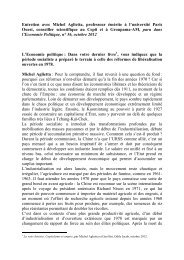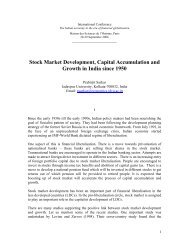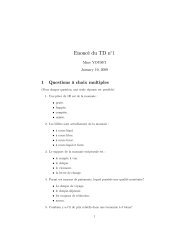The ability <strong>of</strong> managers to convert inputs into outputs is <strong>of</strong>ten influenced byexogenous variables that characterize <strong>the</strong> environment in which production takes place.The question <strong>the</strong>n is how to account <strong>for</strong> <strong>the</strong>se environmental factors?There are three competing approaches regarding <strong>the</strong> way <strong>the</strong> issue <strong>of</strong> environmentis addressed.Environmental factors in <strong>the</strong> production frontierThe first approach assumes that <strong>the</strong> environmental factors influence <strong>the</strong> shape <strong>of</strong><strong>the</strong> technology. There<strong>for</strong>e, <strong>the</strong>se factors should be included directly into <strong>the</strong> nonstochasticcomponent <strong>of</strong> <strong>the</strong> production frontier (e.g., Good et al. (1993)). This leads to amodel <strong>of</strong> <strong>the</strong> <strong>for</strong>mln qi= x β + z γ + v − u'i'iwhere z i is a vector <strong>of</strong> (trans<strong>for</strong>mations <strong>of</strong>) environmental variables and γ is a vector <strong>of</strong>unknown parameters. In this case, it is assumed that each firm faces a differentproduction frontier.Environmental factors in <strong>the</strong> inefficiency termThe second approach assumes <strong>the</strong> environmental factors influence <strong>the</strong> degree <strong>of</strong>technical inefficiency (and not <strong>the</strong> shape <strong>of</strong> technology) and hence that <strong>the</strong>se factorsshould be modeled so that <strong>the</strong>y directly influence <strong>the</strong> inefficiency term 6 . The underlyinghypo<strong>the</strong>ses is that all firms share <strong>the</strong> same technology represented by <strong>the</strong> productionfrontier and that <strong>the</strong> environmental factors have an influence only on <strong>the</strong> distance thatseparates each firm from <strong>the</strong> best practice function.Early empirical papers (e.g. (Pitt & Lee, 1981) and (Kalirajan, 1981)) explore <strong>the</strong>relationship between environmental variables and predicted technical efficiencies using atwo-stage approach. In <strong>the</strong> first stage, <strong>the</strong> firm-specific inefficiency effects assumed to beidentically distributed are retrieved from <strong>the</strong> estimated stochastic frontier. In <strong>the</strong> secondstage, <strong>the</strong> predicted inefficiencies are used as a dependent variable in a regression modelin which explanatory exogenous variables seek to explain differences in <strong>the</strong>se effects(e.g. (Mester, 1993)). This approach is subject to two main weaknesses. One is that, in<strong>the</strong> first stage, when <strong>the</strong> production or cost relationship is estimated, <strong>the</strong> efficiency termsii6 For a comparison <strong>of</strong> <strong>the</strong>se two approaches, see Coelli et al. (1999).-20-
are assumed to be independently and identically distributed, but in <strong>the</strong> second stage <strong>the</strong>yare assumed to be a function <strong>of</strong> <strong>the</strong>se firm-specific factors, implying that <strong>the</strong>y are notidentically distributed 7 . The o<strong>the</strong>r problem is that failure to include environmentalvariables in <strong>the</strong> first stage leads to biased estimators <strong>of</strong> <strong>the</strong> parameters <strong>of</strong> <strong>the</strong> deterministicpart <strong>of</strong> <strong>the</strong> production frontier, and also to biased predictors <strong>of</strong> technical efficiency 8 .These criticisms have given rise to a substantial empirical literature on <strong>the</strong>modeling <strong>of</strong> <strong>the</strong> inefficiency effects, leading to <strong>the</strong> emergence <strong>of</strong> a one-stage approach,whereby <strong>the</strong>se inefficiency effects are modeled jointly with <strong>the</strong> frontier 9 .One approach to estimating <strong>the</strong> effect <strong>of</strong> systematic influences on X-inefficiencyis to assume that <strong>the</strong> truncation point <strong>of</strong> <strong>the</strong> one-sided distribution shifts depending on <strong>the</strong>exogenous factors assumed to determine efficiency. This leads to a model <strong>of</strong> <strong>the</strong> <strong>for</strong>m:ln q = x β + v − ui'ii+ ' 2where u ~ N ( z γ , δ ) , z i is a vector <strong>of</strong> systematic influences on mean efficiency. Thisiiuis known as <strong>the</strong> conditional mean approach ( (Kumbhakar, Ghosh, & McGuckin, 1991),(Huang and Liu, 1994), (Battese & Coelli, 1995)). In this type <strong>of</strong> model, <strong>the</strong> two-sidederror is typically assumed to be2(0,v)iN σ . The main weakness <strong>of</strong> this model is that itdoesn’t take into account <strong>the</strong> possibility <strong>of</strong> heteroskedasticity in <strong>the</strong> variances <strong>of</strong> bothtypes <strong>of</strong> error.In a second approach, (Caudill & Ford, 1993), (Caudill, Ford, & Gropper, 1995),and (Hadri, 1999) seek to address <strong>the</strong> problem <strong>of</strong> heteroscedasticity by parameterizing <strong>the</strong>variance <strong>of</strong> <strong>the</strong> inefficiency term. That is, δ ui is assumed to be δ = g( z , γ ) . However,this model cannot incorporate <strong>the</strong> features <strong>of</strong> <strong>the</strong> conditional mean model by assuming<strong>the</strong> truncation point <strong>of</strong> <strong>the</strong> one-sided distribution to be constant.In a third approach, (Wang, 2002, 2003) combine <strong>the</strong> two models above byparameterizing both <strong>the</strong> mean and <strong>the</strong> variance <strong>of</strong> <strong>the</strong> inefficiency term. That means, u i is+ 2'assumed to be u ~ N ( μ , δ ) , where μ = γ and δ2 = exp( z' γ ) . This model af<strong>for</strong>dsiiu iiz iu iu iii7 Unless all <strong>the</strong> coefficients <strong>of</strong> <strong>the</strong> factors are simultaneously equal to zero.8 For more details, see (Caudill, Ford, & Gropper, 1995, and (Wang & Schmidt, 2002).9 Contributions to <strong>the</strong> development <strong>of</strong> <strong>the</strong> one-stage approach include Khumbhakar, Ghosh and McGuckin(1991); (Reifschneider & Stevenson, 1991); (Yuengert, 1993); (Huang & Liu, 1994); (Caudill, Ford, &Gropper, 1995), (Battese & Coelli, 1995), Wang and Schmidt (2002) and (Wang, 2003) amongst o<strong>the</strong>rs.For a discussion and review <strong>of</strong> this literature, see (Kumbhakar & Lovell, 2000), Ch 7.-21-


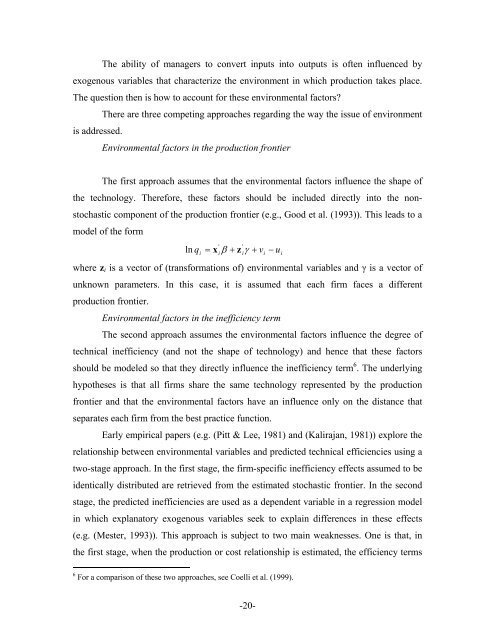

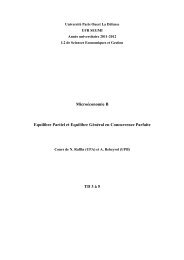

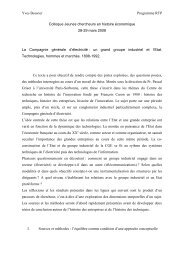

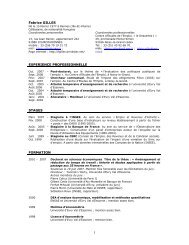
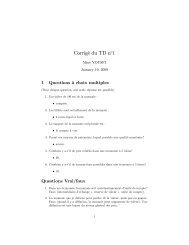
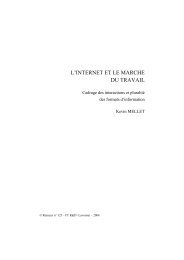
![P * 1 JTZWL_TZY OP^ Sd[Z_Sl^P^ !=m_m]Z^NmOL ... - EconomiX](https://img.yumpu.com/42226403/1/190x143/p-1-jtzwl-tzy-op-sdz-slp-m-mznmol-economix.jpg?quality=85)
